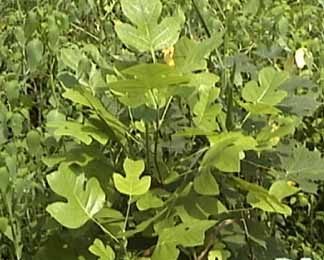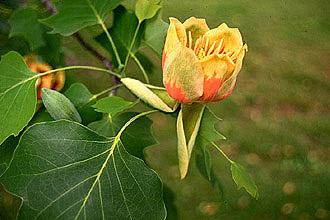Plants and People Project
Tulip Poplar- Liriodendron tulipifera
Also known as Tuliptree, tulip magnolia, canoe wood and Yellow Poplar.
The flowers are somewhat reminiscent of tulips, giving the tree its name.
Wood produces bitter alkaloid chemical called tulipferene which is a heart stimulant. Tuliptree
This tree is the tallest of North American hardwoods, growing to 100 feet or more. Its wood is used to make furniture,cabinetry, musical instruments, and wood veneer.
Native Americans and early pioneers frequently hollowed out a single log to make a long dugout canoe, giving it the common name “canoe tree” in some regions. Daniel Boone is believed to have made a 60 foot long canoe from a single tulip tree. Haverford College Arboretum
"The root of the tuliptree can be used as a lemon-like flavoring agent in spruce beer. The bark contains ‘tulipiferine,’ which is said to have powerful effects on the heart and nervous system.
Tea made from the bark has historically been used to make an aromatic stimulant tonic, which is said to be beneficial in the treatment of rheumatism, chronic gastric and intestinal diseases, dysentery, coughs, and hysteria.
Externally, the tea is used as a wash and a poultice on wounds and boils. Tthe root bark and seeds have been used to expel worms from the body." Shenandoah National Park
The nectar of the flowers are an important food source for bees in the spring. Tulip Poplar is a host plant for tiger and spicebush swallowtail butterflies
Its seeds are eaten by quails, purple finches, rabbits, gray squirrels, and white-footed mice. Yellow-Poplar
It is a wonderful landscape tree with 4 seasons of interest. Due to its potential great height I plant them away from the house.
Identification
and other facts / More
facts
/ Plants
DB /
Arbor
Day facts / Arboretum
Tulip Poplar Sapling


©William S. Justice. Courtesy of Smithsonian
Institution, Dept. of
Systematic Biology, Botany. Used with permission.
DISCLAIMER: These pages are presented solely as a source of INFORMATION and ENTERTAINMENT. No claims are made for the efficacy of any herb nor for any historical herbal treatment. In no way can the information provided here take the place of the standard, legal, medical practice of any country. Additionally, some of these plants are extremely toxic and should be used only by licensed professionals who have the means to process them properly into appropriate pharmaceuticals. One final note: many plants were used for a wide range of illnesses in the past. Be aware that many of the historical uses have proven to be ineffective for the problems to which they were applied.